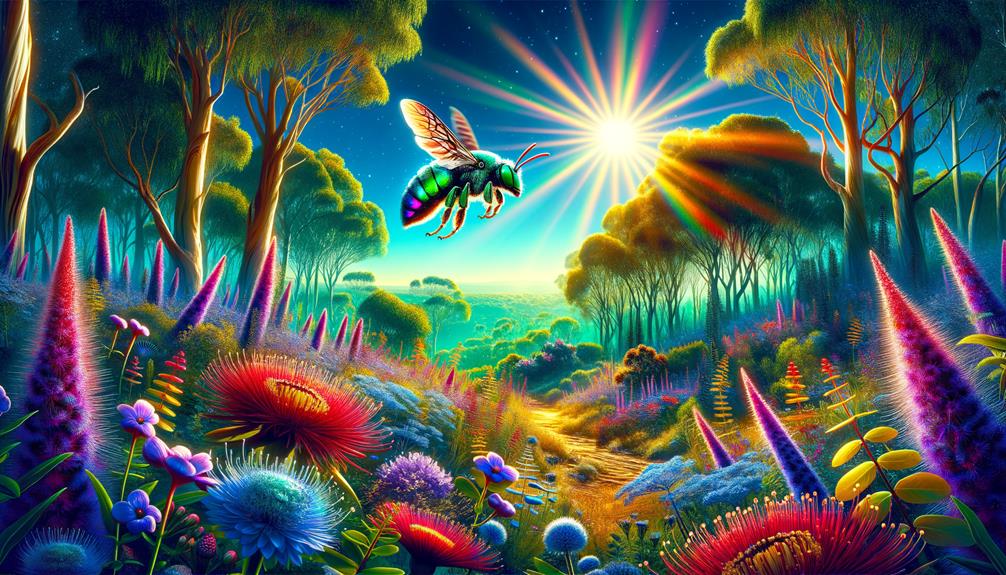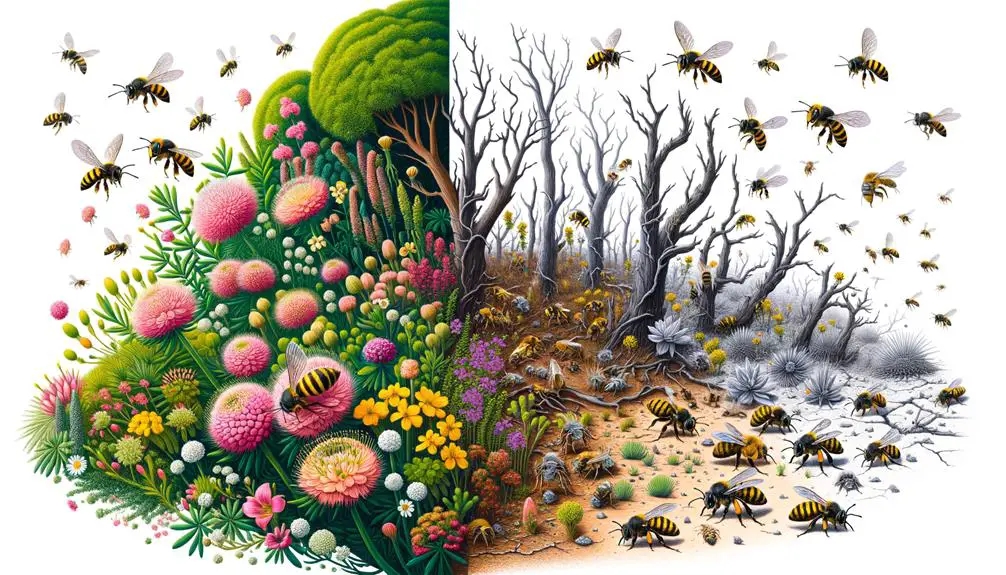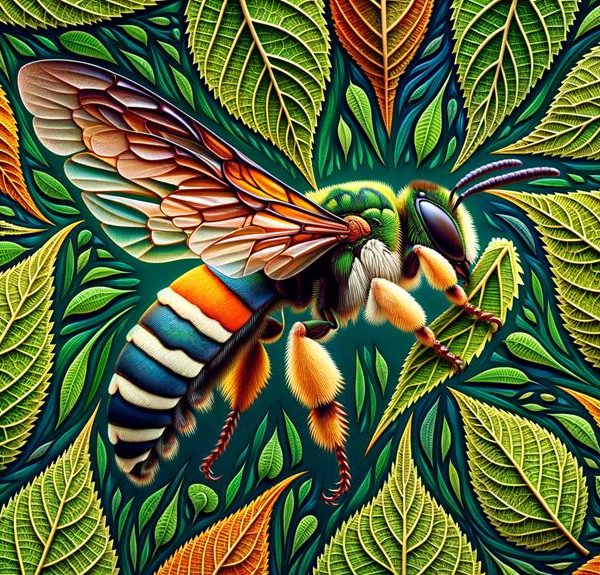Step into the captivating world of Australia's Neon Cuckoo Bees, their vibrant lives unfolding in a tale of intriguing habitats.

Where Do Neon Cuckoo Bee Live?
Have you ever stopped to wonder where the intriguing Neon Cuckoo Bee calls home?
Found primarily in Australia, these bees' vibrant blue and black bodies are a sight to behold. But there's more to these insects than meets the eye.
You might think you know bees, but the habitat of the Neon Cuckoo Bee is a tale that's yet to unfold.
So, stick around, for the journey into their world promises to be as enchanting as the creatures themselves.
Understanding the Neon Cuckoo Bee

To truly comprehend the Neon Cuckoo Bee, you must delve into its unique lifestyle, characterized by its vibrant iridescent blue and green hues, and its intriguing parasitic behavior. The beauty of its colors belies a lifestyle that, you'll find, is far from conventional. Unlike other bees, this species doesn't build nests or gather pollen for their offspring.
The Neon Cuckoo Bee's reproductive strategy is cunning and parasitic. Much like the cuckoo bird, after which it's named, this bee lays its eggs in the nests of other bee species, particularly those of the Blue-banded bee. The unsuspecting host bee is left to rear the Neon Cuckoo Bee's offspring, often at the expense of its own.
When the Neon Cuckoo Bee larva hatches, it consumes the host's pollen and nectar provisions, leaving the host larva starving. This behavior, while seemingly ruthless, is a survival tactic that has evolved over time.
Moreover, the Neon Cuckoo Bee's striking appearance isn't just for show. The vivid colors serve as a warning to potential predators, signifying the bee's unpleasant taste, a defense mechanism known as aposematism. Therefore, understanding the Neon Cuckoo Bee requires appreciating both its beauty and its tactical survival strategies.
The Neon Cuckoo Bee's Habitat

You'll find the Neon Cuckoo Bee residing primarily in Australia, thriving in diverse environments ranging from urban areas to bushlands. Their habitat preference is largely influenced by the presence of their host bees, the Blue-banded bees, whose nests they infiltrate to lay their eggs.
Let's delve into the specifics of the Neon Cuckoo Bee's choice of habitat by breaking it down into four components:
- Urban Areas: They've adapted well to city life, often found in gardens, parks, and other green spaces. They're not put off by human activity, making them a common sight in populated areas.
- Bushlands: These areas offer a natural and abundant source of food and nesting sites. The dense vegetation provides plenty of cover and the diversity of flora supports a variety of bees – their hosts.
- Nesting Sites: They don't build their own nests, but cleverly use the already constructed nests of their host bees, laying eggs in their cells.
- Proximity to Food Sources: They favor habitats close to flowering plants, as the nectar provides the energy they need for their daily activities, while the pollen is crucial for their host bees.
Through this analysis, it's clear that their habitat selection is strategic, ensuring survival and reproduction.
Geographic Distribution of Neon Cuckoo Bees

Building on the understanding of their preferred habitats, let's now examine the broader geographic distribution of Neon Cuckoo Bees across Australia. Likely due to their parasitic lifestyle and specific host requirements, their distribution is somewhat patchy. Nevertheless, you'll find them scattered across most regions of Australia.
Generally, these vibrant bees are concentrated in areas that have a high population of their host bees, the Blue-banded Bees. They're widespread across New South Wales, Queensland, Victoria, and South Australia. There's also a significant presence in parts of Western Australia, mainly coastal and near-coastal areas.
As they're solitary bees, Neon Cuckoo Bees aren't restricted to specific colonies or hives. This allows them to cover more ground and inhabit a wider range of areas, compared to social bees. Their distribution might seem random, but it's closely tied to the availability of their host bees. While they've been spotted in urban gardens and wildlands alike, their presence is most likely wherever Blue-banded Bees are found.
Environmental Requirements for Survival

Understanding the environmental requirements for Neon Cuckoo Bees' survival, it's crucial to note their dependence on specific conditions, primarily defined by the abundance and availability of their host, the Blue-banded Bees.
To ensure their survival, Neon Cuckoo Bees need:
- Abundant Hosts: The Blue-banded Bees serve as their primary host. The female Neon Cuckoo Bees lay their eggs in the nests of Blue-banded Bees. Thus, a healthy population of the host species is vital for their survival and reproduction.
- Flowering Plants: They feed on nectar from flowering plants. So, an environment rich in diverse flowering plant species is necessary.
- Warm Climate: These bees thrive in warm climates, especially in regions with mild winters. They aren't well-adapted to cold climates.
- Natural Habitats: They prefer natural habitats, especially woodland and grassland habitats. They aren't usually found in heavily urbanized areas.
In short, the survival of the Neon Cuckoo Bee depends on a delicate balance of these environmental factors. Any significant changes in any of these could potentially threaten their existence, which is why it's important to protect and maintain their habitats.
Impact of Climate Change on Habitats

Climate change, a formidable adversary, is posing significant threats to the habitats of Neon Cuckoo Bees, potentially disrupting the delicate balance of their survival requirements. This occurs as rising temperatures alter the distribution and availability of their host plants, which are critical for their reproductive cycle.
Moreover, the warming climate is also shifting the timing of pollination events. As you may know, these bees are kleptoparasitic, laying their eggs in the nests of other bee species. The synchrony of these host bees' activities with the flowering of plants is crucial. Climate change, however, is causing a mismatch in these timelines, which could lead to the Neon Cuckoo Bee's eggs being laid before the host nest is ready or the food source is available.
Additionally, extreme weather events such as droughts and heatwaves can lead to the direct mortality of these bees. These conditions can also exacerbate the spread of diseases and parasites, posing further threats to their survival.
Conclusion
You've journeyed through the world of the Neon Cuckoo Bee, understood its unique habitat, mapped its geographical distribution, learnt about its survival needs, and considered the impact of climate change on its home.
It's clear that this iridescent insect isn't just a pretty face – it's a fascinating study in adaptability and resilience. As the world shifts, so must our understanding and efforts to protect these vital pollinators.
Let's not let their glow fade.



